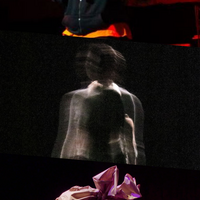Thu 26 May: Mara Vivas/Lawrie Smail (Imbeciles)/Vertebra Theatre

News Story
Mara Vivas Nothingness
Lawrie Smail (Imbeciles) A Hideous Monstrous Verminous Creature
Vertebra Theatre Electra: Untitled
Lawrie Smail writhes in contortions on the floor, a white sack over his head yet immaculate in beige suit and smart brogues. He can’t seem to get up and groans from the pain of his physical labours, thrashing a rigid, spasming body around the stage. Smail’s internal and physical battles reflect those of Gregor Samsa from Kafka’s The Metamorphosis, who wakes to find himself transformed into a cockroach. No monstrous insects here but a sharp, painful metaphor for declining mental health and its downward spiral into suicide. Hard hitting, the solo is imaginatively performed and Anders Duckworth’s raw lighting and beautifully eery film add to its disturbing impact.
Vertebra Theatre follows Smail’s solo as the finishing work of the night with similarly jarring aesthetics (sound, lighting and action). Mayra Stergiou, Piedad Albarracin Seiquer and Susie Fairbrother, all strong female presences, tell their own version of Sophocles’ Greek tragedy, Electra. With skilful manipulation of props –bonding themselves together in a red cloak and elastic band - they move as one, angry, blood-stained and vengeful body. Intense moments of aggressive contact with each other hints at the tragedy’s violence, exacerbated by musician Anna Helena McLean’s scratching, scraping vocals and sombre cello music. While there’s too much to unpack in 25 mins, and confusions arise, Stergiou’s feminist interpretation, delivers a clear message of a wronged woman, viscerally defying patriarchal suppression.
Mara Vivas’s Nothingness begins the evening and offers respite from the emotional turmoil that is to follow. Four women dressed identically creep very gradually on stage. At first I see just toes wiggling from behind the wings, then limbs and bodies begin to emerge. The women are contained, concentrated on their own physical manipulations, testing out pedestrian and technical moves. Silence focusses us on their detail. Occasionally they are aware of each other and make light contact before retreating into their own kinespheres. Punctuated by moments of total stillness, when they move they’re surprisingly busy in their explorations of space and body. Vivas questions nothingness to find new possibilities and that does happen – just painstakingly slowly and quietly.
Josephine Leask
The night opened with Mara Vivas’s Nothingness with the dancer’s limbs appearing and disappearing on stage. The choreographer’s question on emptiness leads her to draw upon Japanese philosophy Wabi-sabi, through which she displays her research by placing four similarly-looking Caucasian women with lilt and delicate comportment dressed in identical costumes. The piece is marked by gestural choreography, a continuous style of Vivas’s, with an abundance of twisting of the wrists as well as shuffling and light skipping of the feet. The Japanese aesthetic of imperfect beauty and acceptance of our transient existence is not easily detectable in the performers’ careful attempt at space sculpting, which adds to the audience’s questions on the significance of the silence and pauses within the movement in the grand scheme of the piece.
Lawrie Smail’s reinterpretation of Kafka’s Metamorphosis shows a body in a beige suit tumbling across the space with acrobatic vigour. As the body exhausts itself accompanied by piercing music, Smail props himself on his neck with his feet in the air. A striking image then appears: a video projection of a tranquil landscape and the projector’s light spills onto Smail’s feet on stage highlighting the incredible control of his upside down body. The skillful light design by Anders Duckworth through showing the audience a half-lit body and diagonal light channel, enhanced the urgency of existential examination that this piece gives prominence to.
Vertebra Theatre has the daunting task of adapting a much-told Greek tragedy Electra into a physical theatre piece with renewed narratives. The performance started with some rhythmic breath work, where three black clothed performers entered the stage in a line. It gradually becomes clear who plays Electra in the ensemble during the moment where she is bound by a white rope and draped in a red piece of fabric. Accompanied by musician Anna Helena McLean’s live cello playing and expressive vocals, the three physical performers' bodies entwined under the red fabric with a slit where their heads extended out, appears to be the strongest part of the piece.
Hazel Lam


